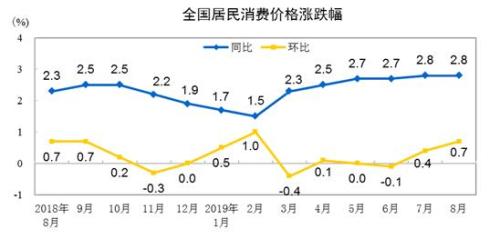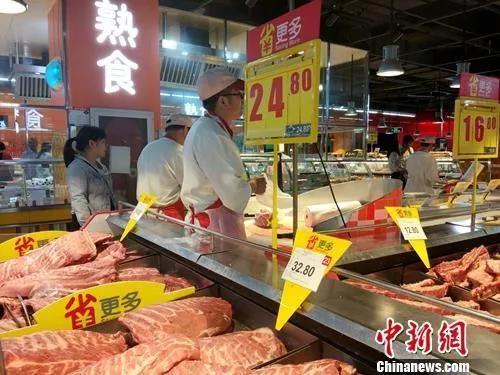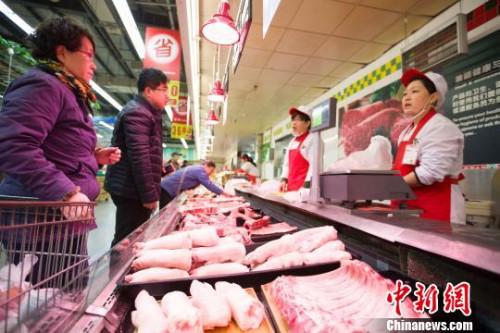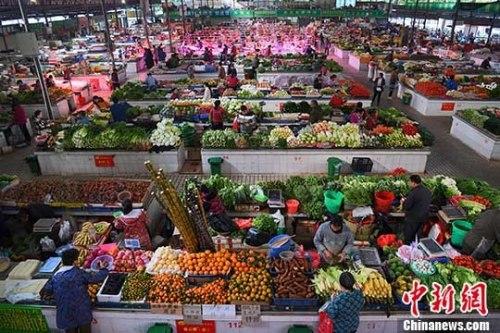In August, the price of pork rose by over 40%, and the price of vegetables fell.
Beijing, Sept. 10 (Reporter Li Jinlei) According to data released by the National Bureau of Statistics on the 10th, the consumer price index (CPI) rose by 2.8% year-on-year in August, the same increase as last month, and it was also in the "2 era" for six consecutive months. Among them, the price of pork rose by more than 40% year-on-year, the increase of fruit began to fall, and the price of vegetables fell for the first time after 18 months of continuous increase.

CPI chart. From the website of the National Bureau of Statistics
CPI rose for six consecutive months in the "2 era"
In August, CPI rose by 2.8% year-on-year, which was the same as that in July. It did not expand or fall back, and continued to maintain the "2 era".
Cao Heping, a professor at Peking University University of Economics, told Zhongxin.com that although the price of pork rose sharply in August, the CPI increase did not continue to expand in August. The main reason was that with the seasonal fruits and vegetables coming on the market, the price increase of fruits narrowed, while the price of vegetables fell, which kept prices stable.
Specific data show that pork prices rose by 46.7% in August, affecting CPI by about 1.08 percentage points; The price of fresh fruit rose by 24.0%, and the growth rate dropped by 15.1 percentage points; The price of fresh vegetables fell by 0.8%, which affected the CPI by about 0.02 percentage points, which was the first decline after 18 months of continuous year-on-year increase.
Shen Yun, senior statistician of the Urban Department of the National Bureau of Statistics, said that according to estimates, among the 2.8% year-on-year increase in August, the impact of price changes last year was about 0.6 percentage points, and the impact of new price increases was about 2.2 percentage points.

Data Map: Pork being sold in the supermarket. Zhongxin. com reporter Li Jinlei
Tight supply, pork prices rose by more than 40%
In the price operation in August, the sharp rise in pork prices is a prominent feature. The price of pork alone affected the CPI increase by about 1.08 percentage points.
According to the data of the Ministry of Agriculture and Rural Affairs, from August 26th to August 30th, the weekly average of the total ex-factory price index of lean pork in 16 provinces (cities) was 35.63 yuan per kilogram, up 9.3% from the previous month and 92.3% from the same period last year.
Why did pork prices soar? In Cao Heping’s view, this is the result of multiple factors. The epidemic situation of swine fever in Africa is superimposed on the "pig cycle", resulting in a decrease in the supply of pigs. At the same time, some places have introduced policies to ban the raising and limit the health of pigs based on environmental protection considerations, which has affected the enthusiasm of breeding pigs, resulting in a large decline in the production capacity of pigs and a tight market supply, which has pushed up the price of pork.

Data Map: People buy pork. Photo by Zhang Yun
How long is the rise in pork prices expected to last?
Regarding the future trend of pork price, Jiang Chao, chief economist of Haitong Securities, pointed out that whether the soaring pig price can come down fundamentally still depends on whether the supply of pigs can be restored.
Jiang Chao said that it will take 4-6 months from fattening piglets to slaughter. Considering the time lag of reproduction and growth from fattening sows to slaughter pigs, it is expected that there will still be upward pressure on pig prices in the second quarter of next year.
Cao Heping believes that it is difficult to eliminate the influence of African swine fever in the short term, and the pig production capacity will be difficult to return to the normal level for a while, so the pork price will maintain an upward trend in the short term. However, with the efforts of the state to stabilize the production and supply of pigs, the enthusiasm for raising pigs will increase, and the increase in pork prices will tend to be stable.
Xin Guochang, director of the Monitoring Information Department of the Animal Husbandry and Veterinary Bureau of the Ministry of Agriculture and Rural Affairs, said that judging from the decline in the number of live pigs and fertile sows since the second half of last year, pork production may be significantly reduced this year, and there is a certain gap between supply and demand in the market. It is expected that pig production will gradually recover in the second half of next year, and the price of live pigs will gradually fall.

Data Map: People buy fresh vegetables. China News Service reporter Hu Yanshe
Will the annual CPI increase exceed 3%?
Statistics from the National Bureau of Statistics show that the CPI in the first eight months increased by 2.4% compared with the same period of last year. Some people worry that, driven by pork prices, the annual CPI may exceed the expected control target of 3%.
Lian Ping, chief economist of Bank of Communications, believes that the recent year-on-year increase in CPI has remained at a high level, mainly due to the food price driven by pork. Considering that the number of live pigs and fertile sows brought by the swine fever epidemic is still declining rapidly, the increase in pork prices will still be an important factor driving the increase in CPI in the second half of the year.
Li Chao, chief macro researcher of Huatai Securities, believes that domestic pork prices have risen rapidly recently, but there is little pressure on other new price increase factors except pig prices. The upward pressure on overall CPI is still controllable, and there is little risk that inflation will break through 3% in the short term.
Cao Heping said that the CPI rose by 2.4% in the first eight months, and there are only three months left this year. It is unlikely that the CPI will exceed 3% in the whole year, but it is still necessary to closely monitor and be alert to price increases. (End)